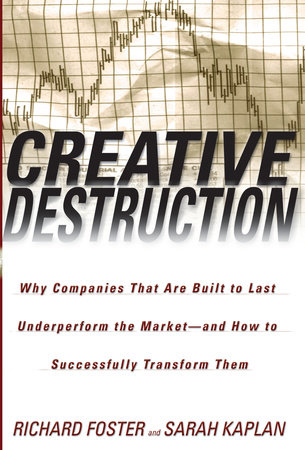creative destruction

Summary
Turning conventional wisdom on its head, Creative Destruction debunks the myth that high-octane, built-to-last companies can continue to excel year after year and reveal the dynamic strategies of discontinuity and creative destruction these corporations must adopt in order to maintain excellence and remain competitive.
In striking contrast to such bibles of business literature as In Search of Excellence and Built to Last, Richard N. Foster and Sarah Kaplan draw on research they conducted at McKinsey & Company of more than one thousand corporations in fifteen industries over a thirty-six-year period. The industries they examined included old-economy industries such as pulp and paper and chemicals, and new-economy industries like semiconductors and software. Using this enormous fact base, Foster and Kaplan show that even the best-run and most widely admired companies included in their sample are unable to sustain their market-beating levels of performance for more than ten to fifteen years. Foster and Kaplan’s long-term studies of corporate birth, survival, and death in America show that the corporate equivalent of El Dorado, the golden company that continually outperforms the market, has never existed. It is a myth.
Corporations operate with management philosophies based on the assumption of continuity; as a result, in the long term, they cannot change or create value at the pace and scale of the markets. Their control processes, the very processes that enable them to survive over the long haul, deaden them to the vital and constant need for change. Proposing a radical new business paradigm, Foster and Kaplan argue that redesigning the corporation to change at the pace and scale of the capital markets rather than merely operate well will require more than simple adjustments. They explain how companies like Johnson and Johnson, Corning, and GE are overcoming cultural “lock-in” by transforming rather than incrementally improving their companies. They are doing this by creating new businesses, selling off or closing down businesses or divisions whose growth is slowing down, as well as abandoning outdated, ingrown structures and rules and adopting new decision-making processes, control systems, and mental models. Corporations, they argue, must learn to be as dynamic and responsive as the market itself if they are to sustain superior returns and thrive over the long term.
In a book that is sure to shake the business world to its foundations, Creative Destruction, like Re-Engineering the Corporation before it, offers a new paradigm that will change the way we think about business.
Harvard Business Review‘s Top 10 Business Book of 2001 and a BusinessWeek best seller.
Praise for Creative Destruction
“A thoroughly researched, masterfully written, and somewhat frightening explanation of how competitive advantage is built and inevitably erodes. Anyone who is interested in staying ahead of the competition should read this book. It’s good.”
—Clayton Christensen, Professor, Harvard Business School, and author of The Innovator’s Dilemma.
“[Offers] invaluable insight into business building and dealing with the challenge of dynamic growth. Foster and Kaplan get right to the heart of one of today’s central themes. An instructive and insightful guide for managers to navigate the twenty-first century.”
—Jorma Ollila, Chairman and CEO, Nokia Corporation
“It was clear the game had changed, but until this book it was never clear by how much. Creative Destruction will reverberate in corporate boardrooms for some time to come, changing the basic premises of corporate success. There is no doubt that, in order to survive in the future, inspiration can be found in Foster’s and Kaplan’s book”
—Antony Burgmans, Chairman, Unilever, N.V.
“Creative Destruction is a phenomenal book. It reveals what it takes for an enterprise to thrive in the age of discontinuities yet meet the pressures of continuous performance. Wise, sweeping, balanced, grounded in facts and yet highly imaginative, it is unquestionably the best business book I have ever read Countless numbers of CEOs will wish they could have read it sooner—and so will their shareholders.”
—John Seely Brown, President, Xerox Palo Alto Research Center
“Creative Destruction has clarified for me the challenges of sustaining business success. It is the freshest view of the challenges before us that I have seen. It also shows where we have to change to be successful. Compelling.”
—Vernon Jordan, Lazard.
“Creative Destruction is a sharp stick in the eye for corporate conventional wisdom and orthodoxy. Foster and Kaplan have captured the essence of market-driven counterinitiative thinking. A wake-up call for CEOs and investment strategists!”
—Joe L. Roby, Chairman, Credit Suisse First Boston Corporation
